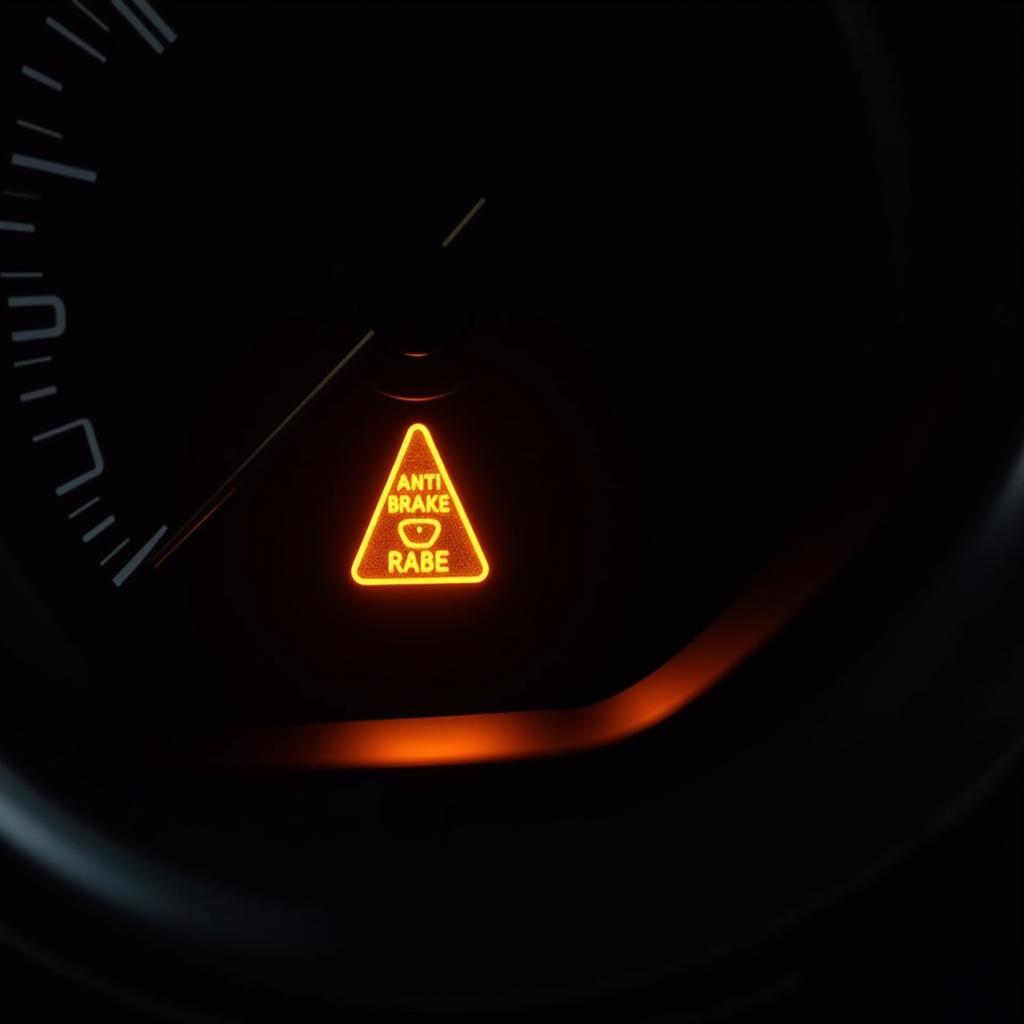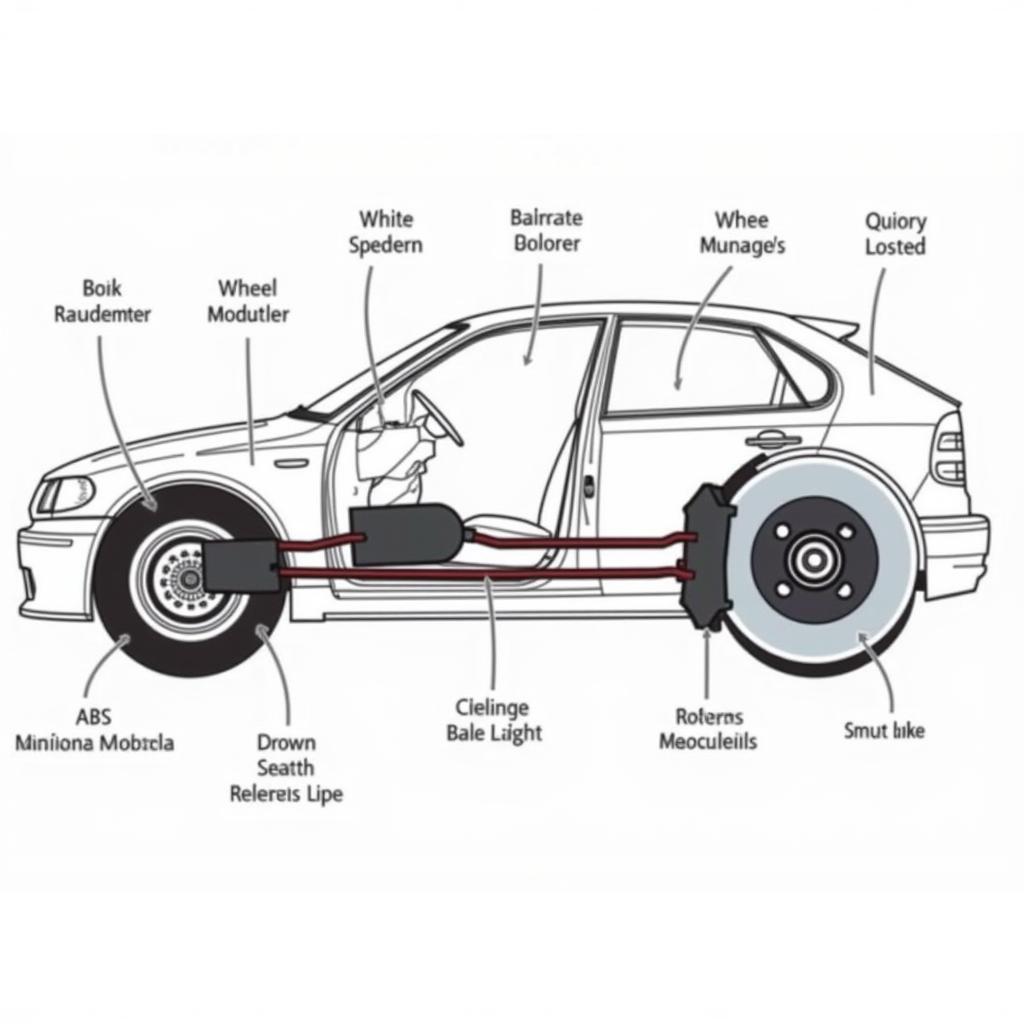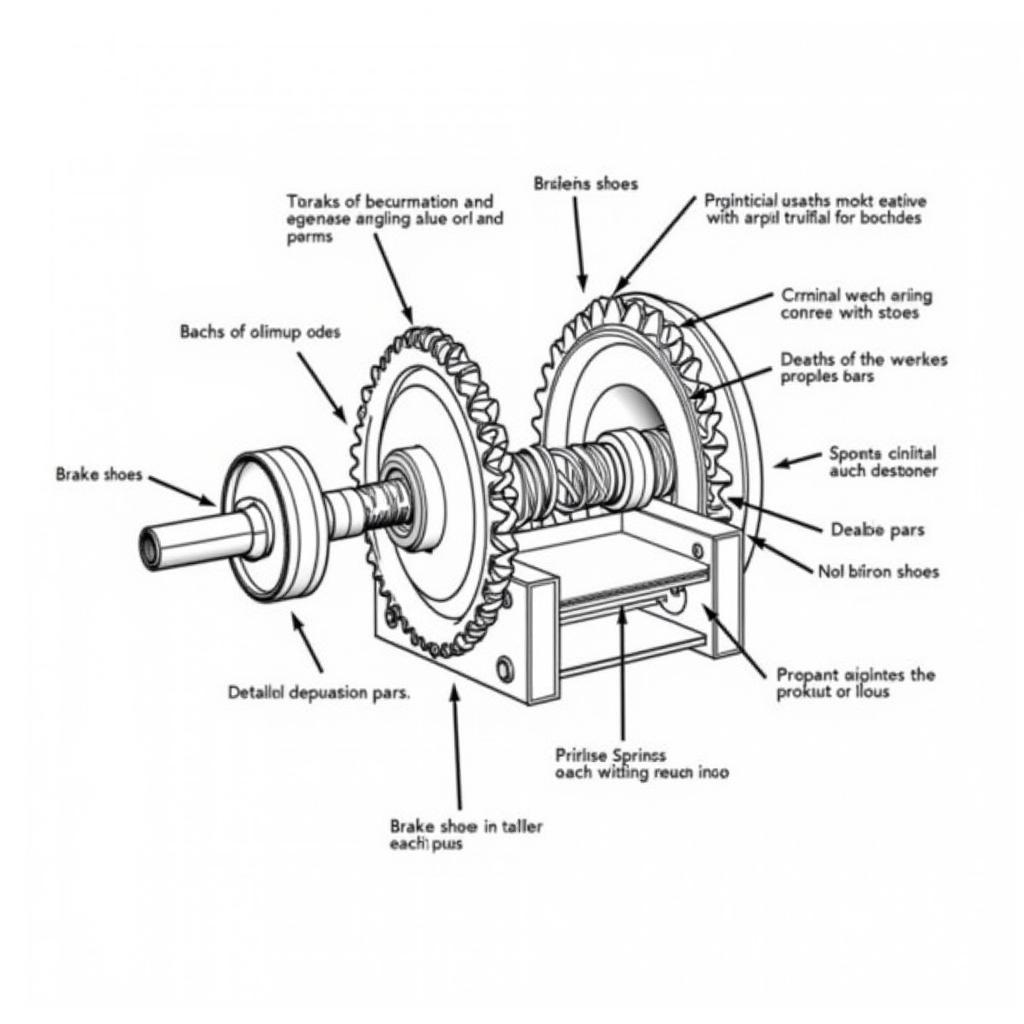Imagine this: you’re driving down the road, and suddenly, a bright light on your dashboard catches your eye – the dreaded anti brake warning light. Your heart might skip a beat as you wonder, “What does this mean? Is my car safe to drive?”. Don’t panic! This article will guide you through understanding anti brake warning lights, what causes them, and what steps you can take to address the issue.
What are Anti-Brake Warning Lights?
Anti-brake warning lights, often appearing as an exclamation mark within a circle or the letters “ABS”, signal a potential problem with your vehicle’s braking system. This system, known as the Anti-lock Braking System (ABS), is a crucial safety feature that prevents your wheels from locking up during sudden braking.
 Anti-brake warning light on car dashboard
Anti-brake warning light on car dashboard
A functioning ABS system helps you maintain steering control and stability, especially on slippery roads, by ensuring that the wheels keep spinning and maintain traction. While it might feel strange or even counterintuitive when the ABS kicks in, it’s designed to help you stop safely and avoid accidents.
Why is My Anti Brake Warning Light On?
Several factors can trigger your anti brake warning light. Understanding these causes can help you narrow down the problem and seek the appropriate solution:
- Faulty ABS Wheel Speed Sensor: One of the most common culprits is a malfunctioning wheel speed sensor. These sensors, located at each wheel, monitor wheel speed and relay that information to the ABS control module. A faulty sensor can disrupt this communication, leading to the warning light.
- ABS Control Module Issues: The ABS control module is the brain behind the entire system, processing data from various sensors and regulating brake pressure. If the control module itself malfunctions due to electrical issues or internal faults, the anti brake warning light will likely illuminate.
- Low Brake Fluid Levels: Your car needs adequate brake fluid for the braking system to function correctly, including the ABS. Low brake fluid, often caused by leaks, can trigger the warning light.
- Brake Fluid Contamination: Over time, brake fluid can become contaminated with moisture and debris, affecting its performance and potentially damaging the ABS components.
- Blown Fuse: A blown fuse in the ABS system’s electrical circuit can also be the culprit. Fuses act as safety devices, and a blown fuse will interrupt the power supply to the ABS system.
- Damaged Wiring or Connectors: Wiring harnesses and connectors within the ABS system can become damaged due to wear and tear, corrosion, or rodent activity.
 Car brake system components diagram
Car brake system components diagram
What Should You Do When Your Anti Brake Warning Light Comes On?
If you notice your anti brake warning light illuminated, it’s essential to take action promptly:
- Don’t Panic: While the warning light signals a potential issue, it doesn’t necessarily mean your brakes have completely failed.
- Assess Your Surroundings: If possible, safely pull over to the side of the road to avoid potential hazards.
- Check Your Brake Fluid: Carefully inspect your brake fluid reservoir. If the fluid level is low, add the appropriate brake fluid as specified in your car’s owner’s manual.
- Proceed with Caution (If Safe): If you’ve checked the brake fluid and it seems okay, you can cautiously continue driving. However, avoid sudden braking or high speeds. Remember that your ABS might not function correctly.
- Schedule a Professional Inspection: As soon as possible, schedule an inspection with a qualified mechanic specializing in automotive electrical systems and brake systems.
Remote Diagnostics and Programming: A Modern Solution
In today’s technologically advanced automotive landscape, remote diagnostics and programming have emerged as powerful tools for diagnosing and resolving issues like anti brake warning lights. Certified technicians can remotely connect to your vehicle’s onboard computer system to:
- Read and interpret fault codes: This helps pinpoint the specific area of the ABS system that requires attention.
- Analyze real-time data: By monitoring live data streams from various sensors, technicians can identify underlying causes and patterns.
- Perform software updates and reprogramming: In some cases, a software glitch or outdated software within the ABS control module can trigger the warning light. Remote programming allows technicians to address these issues effectively.
Can I Drive With the Anti Brake Warning Light On?
While it might be tempting to ignore the anti brake warning light, especially if your brakes seem to be working fine, it’s strongly advised against driving for extended periods with the light on. Here’s why:
- Safety Risks: A malfunctioning ABS system compromises your vehicle’s ability to brake safely, increasing the risk of accidents, especially in emergency situations.
- Potential for Further Damage: Ignoring the warning light and continuing to drive with a faulty ABS system could lead to more severe damage, resulting in costly repairs.
Preventative Measures to Avoid Anti Brake Warning Lights
You can take several proactive steps to minimize the chances of encountering anti brake warning lights:
- Regular Brake Inspections: Adhere to your car manufacturer’s recommended maintenance schedule for brake inspections.
- Timely Brake Fluid Flush: Have your brake fluid flushed and replaced at regular intervals, typically every two to three years, to prevent contamination.
- Careful Driving Habits: Avoid harsh braking whenever possible.
- Address Warning Lights Promptly: If any warning lights illuminate on your dashboard, don’t ignore them.
Conclusion
Anti brake warning lights are crucial safety indicators that should never be disregarded. Understanding their meaning and taking prompt action can help ensure your safety on the road and prevent potentially costly repairs. By staying informed about your vehicle’s brake system and utilizing modern diagnostic solutions like remote programming, you can confidently address anti brake warning lights and maintain a safe and reliable driving experience. Remember, when it comes to brakes, prevention and early intervention are always better than cure.
Frequently Asked Questions
1. What is the difference between an anti brake warning light and a regular brake warning light?
A regular brake warning light usually indicates a problem with your traditional braking system, such as low brake fluid. An anti brake warning light specifically signals an issue with the ABS, which is an additional safety feature on top of your regular brakes.
2. Will my car stop if the ABS light is on?
Yes, your car will still stop if the ABS light is on. However, the ABS function might be disabled, meaning your wheels could lock up under hard braking.
3. Can I reset the anti brake warning light myself?
While it’s possible to reset the warning light by disconnecting the car’s battery, it’s not recommended unless you’ve addressed the underlying issue. The light will likely reappear if the problem persists.
4. Is it expensive to fix an ABS problem?
The cost of repairing an ABS issue can vary widely depending on the root cause and the make and model of your vehicle.
5. Can a faulty ABS sensor affect other systems in my car?
In some cases, a faulty ABS sensor can affect other systems that rely on wheel speed data, such as traction control or stability control.

